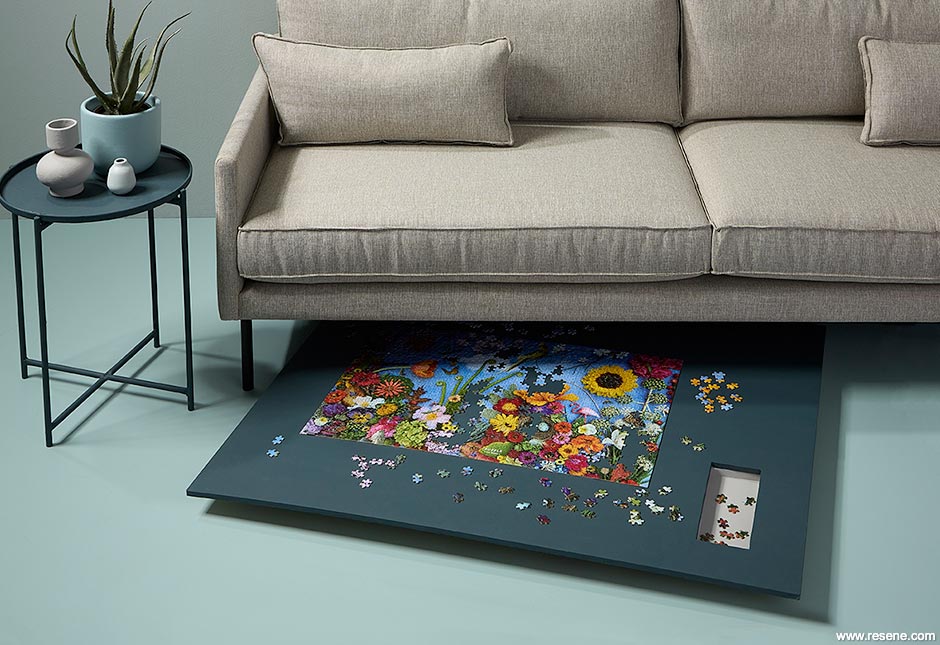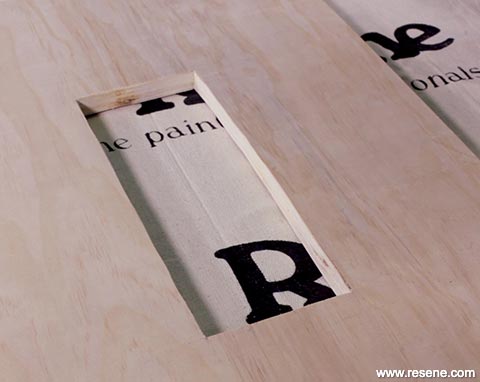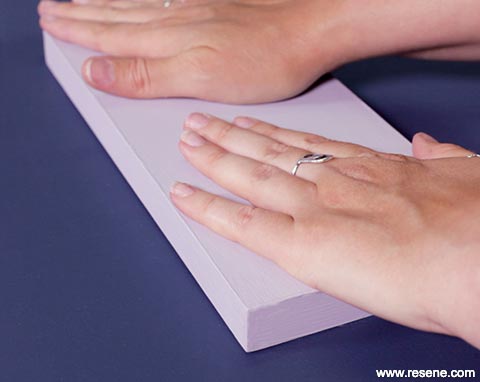From Habitat magazine - issue 34, step by step
This clever table coasts on castors so that you can easily tuck it beneath your sofa.

Step 1: Measure the distance between the bottom of your sofa and the floor (vertical clearance), as well as the distance between your front two sofa legs (horizontal clearance) and between your front and back sofa legs (depth). Our sofa has a vertical clearance of 100mm, a horizontal clearance of 2000mm and a depth of 920mm, so we decided to make our table 1200mm x 800mm so that it was big enough for a 2000 piece puzzle. However, you may need to adjust the dimensions if your sofa is shorter or shallower. If your sofa's vertical clearance is lower, you may need to choose shorter castors or adjust the design of your project accordingly.
Step 2 (optional): Using a power drill and a jig saw, cut a 260mm x 100mm opening near the bottom right corner of your table. Be sure the bottom left corner of your opening is at least 150mm from the bottom and left side of your table so that your castors and brakes will have enough room to rotate.
 Step one
Step one
 Step two
Step two
 Step three
Step three
Step 3: Patch any flaws in the surface of your plywood using wood filler and a putty knife then allow it to dry. Using a palm sander and sandpaper or a sanding block, smooth all surfaces and cut edges then wipe all surfaces free from sawdust using a clean dry cloth.
Step 4: Prime all surfaces of your plywood and tray using Resene Quick Dry waterborne primer undercoat with a mini roller. Allow the primer to dry fully before moving on.

Step three contd.

Step four

Step four contd.
Step 5: Paint your plywood using two coats of Resene Lustacryl semi-gloss waterborne enamel in your choice of colour. We used Resene Coast. Allow your first coat to dry before applying the second.
Step 6 (optional): While your plywood is drying, paint your tray using a Resene testpot in your choice of colour in two coats. We used Resene Half Jumbo. Allow your first coat to dry before applying the second.
Step 7: On the underside of your plywood, measure 100mm vertically and horizontally in from each side and lightly mark where they meet with a pencil. These marks will be where the outer corner of your castors will be placed.

Step five

Step six

Step seven
Step 8: Use a pencil to mark where each screw hole is. Drill shallow pilot holes where you've made your pencil marks no more than 10mm deep, then attach castors with 15mm long wood screws.
Step 9 (optional): Apply wood glue around the top edges of your painted tray and adhere it to the underside of your plywood centred over the cut opening. Stack heavy books on top to weigh it down while the glue dries.
Optional: Remove legs from an old TV tray table or card table and attach these to the bottom of your puzzle/game table.

Step eight

Step eight contd.

Step nine
 Step nine contd.
Step nine contd.
 This handy sunken compartment can hold spare puzzle pieces or dice.
This handy sunken compartment can hold spare puzzle pieces or dice.
Video: For a video on how to make this puzzle table, visit www.habitatbyresene.com/diy-puzzle-table.
Top tip: If you want to work on your puzzle higher up, simply lock the wheels and place it on top of a table or bench. Whenever you need a break, place your puzzle table back on the floor, unlock the wheels and roll it back under your sofa or create folding legs that tuck away when stored.
project and styling: Laura Lynn Johnston
images: Bryce Carleton, Ben Whorwood
Search habitat magazine stories
Printed copies of habitat highlights are available from late March 2024 at Resene ColorShops and resellers, while stocks last. You can view back issues of habitat magazine online.
Specifiers:
If you have an idea, project or story that you think would suit habitat, we’d love to hear from you. Please drop us an email with your details and include photos if submitting a project.
Sign up for a DIY card and Save! Australia | New Zealand